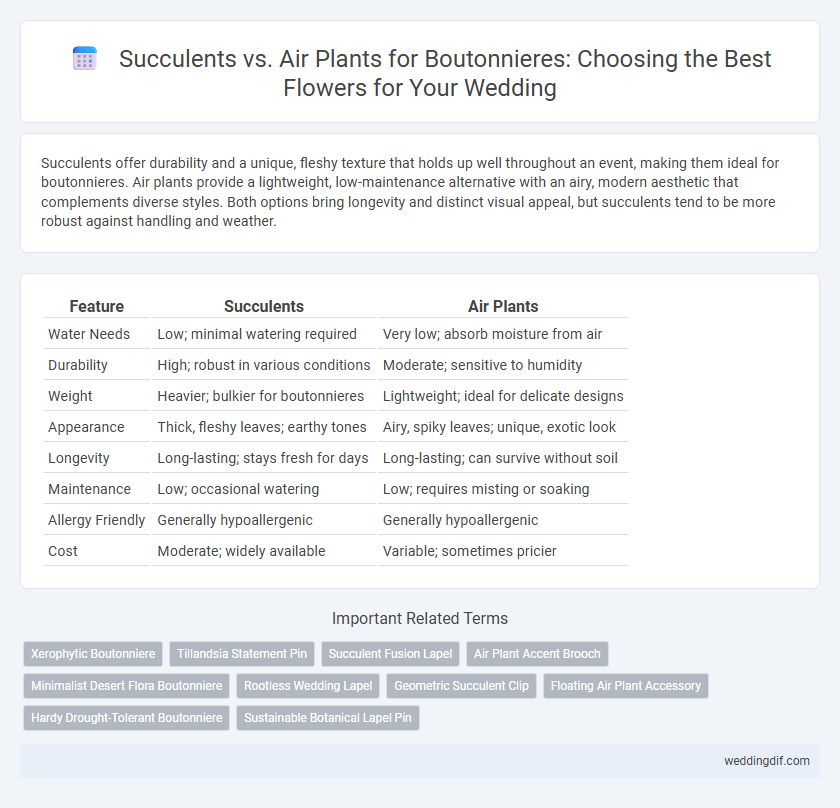Succulents offer durability and a unique, fleshy texture that holds up well throughout an event, making them ideal for boutonnieres. Air plants provide a lightweight, low-maintenance alternative with an airy, modern aesthetic that complements diverse styles. Both options bring longevity and distinct visual appeal, but succulents tend to be more robust against handling and weather.
Table of Comparison
| Feature | Succulents | Air Plants |
|---|---|---|
| Water Needs | Low; minimal watering required | Very low; absorb moisture from air |
| Durability | High; robust in various conditions | Moderate; sensitive to humidity |
| Weight | Heavier; bulkier for boutonnieres | Lightweight; ideal for delicate designs |
| Appearance | Thick, fleshy leaves; earthy tones | Airy, spiky leaves; unique, exotic look |
| Longevity | Long-lasting; stays fresh for days | Long-lasting; can survive without soil |
| Maintenance | Low; occasional watering | Low; requires misting or soaking |
| Allergy Friendly | Generally hypoallergenic | Generally hypoallergenic |
| Cost | Moderate; widely available | Variable; sometimes pricier |
Succulents vs. Air Plants: A Modern Boutonniere Dilemma
Succulents offer durability and a range of textures, making them ideal for long-lasting boutonnieres that maintain freshness throughout the event. Air plants, prized for their unique, sculptural appearance and minimal water needs, provide a lightweight and maintenance-free alternative. Choosing between succulents and air plants depends on desired aesthetics, longevity, and care preferences for modern boutonniere designs.
Aesthetic Appeal: Comparing Succulents and Air Plants
Succulents offer a bold and textured aesthetic with their fleshy leaves and rich green hues, making boutonnieres stand out with a natural, sculptural appeal. Air plants provide a lighter, more delicate look with their wispy, intricate forms and silvery-green tones, ideal for a subtle and airy boutonniere design. Both options bring unique visual interest, but succulents tend to convey a more robust and modern vibe, while air plants emphasize elegance and minimalism.
Durability and Longevity in Wedding Boutonnieres
Succulents offer exceptional durability and longevity in wedding boutonnieres, thriving in various conditions without wilting quickly. Air plants, while visually unique and lightweight, require careful handling and some moisture, which may limit their lifespan during outdoor ceremonies. Choosing succulents ensures a lasting, fresh appearance that holds up well throughout the wedding day.
Color and Texture: Unique Features of Succulents and Air Plants
Succulents offer rich, fleshy textures with vibrant greens and deep purples, creating a bold, tactile statement for boutonnieres. Air plants display a delicate, wispy texture with silvery or muted green hues, adding an ethereal and airy touch. Both provide unique color contrasts and dimensional appeal, enhancing boutonniere design with natural elegance.
Comfort and Wearability for Groomsmen
Succulents offer a sturdy structure and natural moisture retention, making boutonnieres comfortable for all-day wear, especially in warm climates. Air plants are lightweight and breathable, contributing to a less bulky feel but may require extra securing to prevent movement. Groomsmen benefit from succulents' durability and air plants' delicate appearance, both enhancing comfort and style without compromising wearability.
Sustainability and Eco-Friendliness in Floral Choices
Succulents and air plants offer sustainable alternatives for boutonnieres due to their low water requirements and long-lasting nature. Succulents retain moisture and thrive with minimal care, reducing environmental impact through less frequent watering and longer shelf life. Air plants absorb nutrients from the air, eliminating the need for soil and enabling eco-friendly cultivation with minimal resources.
Maintenance and Care Before the Big Day
Succulents require minimal watering and thrive in dry conditions, making them low-maintenance for boutonnieres before the big day. Air plants need regular misting or soaking every few days to stay hydrated, which demands more attention in the preparation phase. Both options are durable but succulents typically last longer without frequent care, offering added reliability for event timelines.
Cost Comparison: Succulents vs. Air Plants for Boutonnieres
Succulents typically cost between $3 to $6 per piece, making them an affordable choice for boutonnieres, whereas air plants can range from $5 to $10 each due to their slower growth and unique care requirements. Succulents offer durability and easy maintenance, which can reduce replacement or repair costs, while air plants' higher price reflects their exotic appeal and minimal soil needs. Budgeting for boutonnieres depends on quantity and style preference, with succulents providing a cost-effective option and air plants delivering a distinct, premium aesthetic.
Personalization: Creative Design Ideas for Each Plant
Succulents offer a sturdy, textured option for boutonnieres, allowing for personalization through vibrant hues and geometric shapes that complement various suit styles. Air plants provide a unique, minimalist aesthetic with their delicate, wispy leaves, enabling creative designs featuring wire coils or small decorative bases to enhance elegance. Both plants allow for customization with added elements like tiny blooms or decorative moss, ensuring a tailored and memorable boutonniere.
Choosing the Right Plant for Your Wedding Theme
Succulents offer a modern, sturdy option for boutonnieres, providing a variety of shapes and colors that complement rustic and bohemian wedding themes. Air plants, known for their minimal care and unique, ethereal appearance, fit well with minimalist or tropical wedding aesthetics. Selecting between succulents and air plants depends on the desired texture, maintenance level, and overall floral harmony within the wedding design.
Succulents vs air plants for boutonnieres. Infographic

 weddingdif.com
weddingdif.com